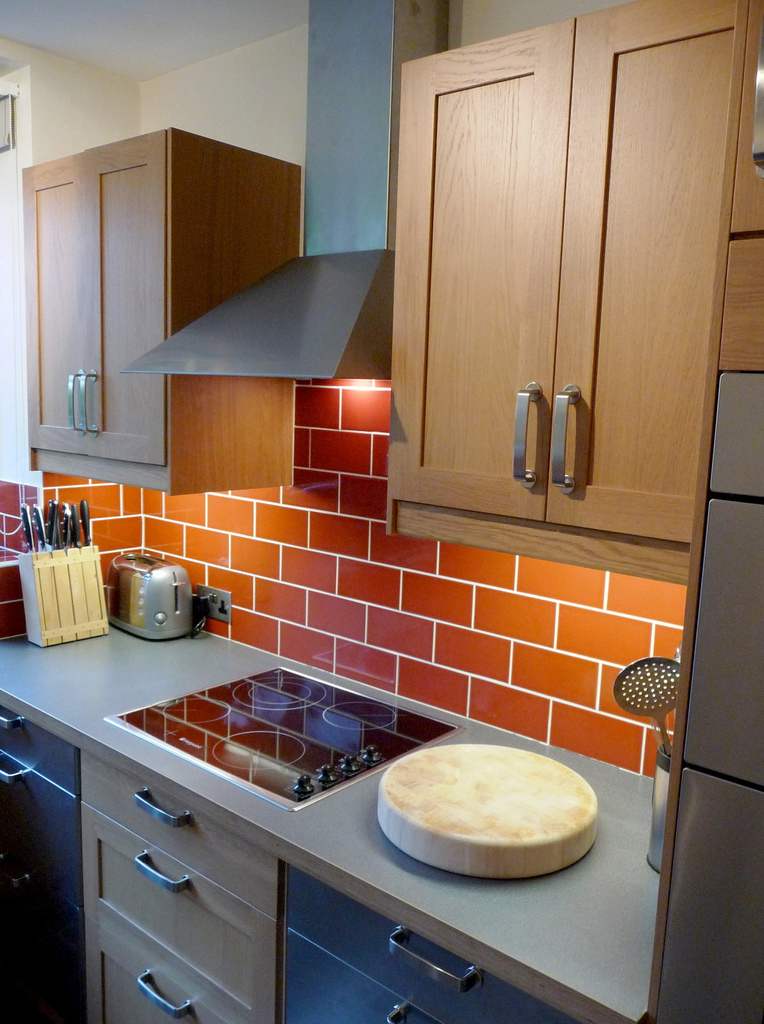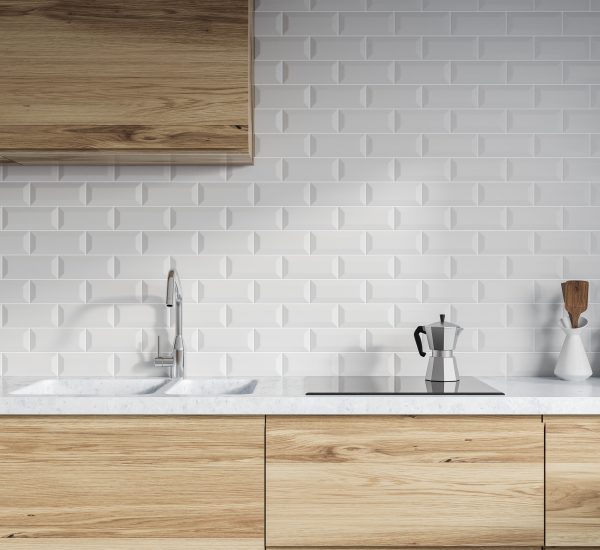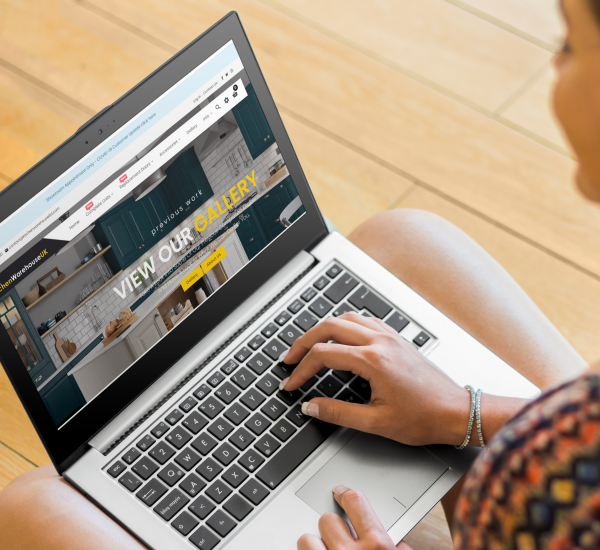Protecting your walls from splashes and general mess isn’t anything new. After all, everyone wants to make sure that their kitchen is kept simple to maintain and spotless for the long term, right?
Given that they’re easy to clean and don’t mark in the same way that paint or wallpaper will, tiles are a no brainer in the kitchen. But we’re sure you can appreciate the benefits of kitchen splashbacks, too.
Deciding whether to have a splashback or tiles on your walls can be an especially tough call, as there are multiple advantages to having both. In this Kitchen Warehouse blog post, we’re here to look at both kitchen splashbacks and tiling in a little more detail, so you can decide which is the best method of protecting your walls from the inevitable wear and tear of the kitchen.
What is a kitchen splashback?
The premise of a kitchen splashback is actually quite simple, with a clue of its use given in the name. It is specifically designed to stop any splashes or spillages harming your walls. Splashbacks can be made from a range of materials, including plastic, glass, or even stainless steel.
When you’re bringing pasta or vegetables to the boil, notice how water splashes all over the kitchen – particularly the walls behind the stove?
Water is one issue, but what if it’s tomato pasta sauce? A kitchen splashback will help catch these rogue elements and ensure that they’re easy to wipe without leaving a stain on your trendy walls.
Many kitchens that have been wallpapered have a small section behind the cooker that is covered by a sheet of glass. This will catch any loose liquids so they can be cleaned easily after you’re done preparing food.
Advantages of a kitchen splashback
When evaluating whether to opt for a splashback or tiles in your kitchen, it’s important to weigh up the advantages of both. One of the main reasons why so many people are deciding to buy splashbacks instead of tiles is purely from an aesthetic point of view. As both perform largely the same function, the look of a splashback can be a true deciding factor in your decision. This is because it can often be much easier to colour match your splashback to the rest of your room, giving you greater consistency in that stellar kitchen look we all strive for.
Finding the right shade of tile can be difficult, whereas a splashback generally comes in one solid colour. So if you have black kitchen cabinets, for example, and you want to complement this with an accent colour such as red, then getting a red splashback is a much easier route than installing red tiles.
In a world where we’re all searching for the most value for money option out there, it’s important to note that, in many cases, a kitchen splashback is seen as the more durable option of the two. You needn’t worry about the grouting becoming dislodged or damaged, so splashbacks can therefore keep their aesthetic appeal for longer.
That being said, tiles are still a popular option for many, and there are some big reasons for this.
Tiles have their advantages too
Aside from the fact that many people prefer the traditional option of tiles in their kitchen, they can often be a better fit for your kitchen design and simply make more sense. It might be somewhat easier to find a splashback that matches your exact colour requirements, but some kitchens actually suit a tiled finish better. You can also mix and match tiles if you’d like to create a real stand out look, making your kitchen unique from the rest and really stamping your identity on the room.
The durability of some splashbacks out there also raises the question of whether tiles are the better option for the long term. Whilst many are strong and will last a long time, glass splashbacks in particular are prone to breaking much easier than tile.
If you would like to create a more traditional feel in your kitchen, tile is definitely the way to go.

How to choose a kitchen splashback: initial decisions
It’s important to note just how much choice there is out there when it comes to deciding on your favourite kitchen splashback.
Most people will begin by picking their countertop and the colour of their kitchen units first before considering how the splashback and colour can tie in.
However, you may wish to start with the colour of the splashback instead, making it a feature of the room and working your choice of kitchen colours around that. Either approach here works well, ensuring you can have a consistent theme throughout your kitchen.
With so many choices at your disposal, it’s worth narrowing your quest for the perfect kitchen splashback down to a few key areas.
Kitchen splashback material
You may be surprised to know that tiling actually classes as a kitchen splashback and is a perfectly acceptable material to use.
However, should you require an alternative material, you can look towards glass. Its effortlessness to clean makes it a very attractive option for those that want a stand out kitchen that is easy to maintain, with a glass kitchen splashback providing a streamlined, contemporary look. They’re also a useful addition because of their reflective qualities, as they can bounce light around the kitchen, helping a smaller space appear larger than it actually is.
Getting the colour right
If you’ve already got the look of your countertop material sorted, you’ll probably have narrowed down your splashback colour option. But if not, here are some things to consider. If you want the countertop to take centre stage, a minimal and subtle look is probably the best option for your splashback. This should ensure that attention is not drawn away from the benchtop.
On the other hand, if your countertops have a neutral colour, you might consider adding a splash (pardon the pun) of colour to the splashback to make it a real focal point and feature of the kitchen.
If you’re longing for some consistency in the appearance of your kitchen, choose a colour similar in tone to your countertop. If you want to create more of a focal point, choose a colour that contrasts with the shade of your countertop. Similar tones can be effective, but equally the contrast of light and dark also works well.
If you have your heart set on having a bold colour for your splashback, it’s important that the colour of the countertops complement your commitment. The last thing you want is for different elements of the kitchen vying for attention, taking away from the visually appealing intention.
How to choose the best kitchen tiling for you
Much like their splashback counterparts, there are some things to consider before you decide on which tiling will sit pride of place in your kitchen. The appearance of such a commonly used room is sure to mean a lot to you, so by spending some extra time weighing up your options, you’ll be sure you’ve made the right choice!
Materials
For tiling, there are many more materials that could be used than a kitchen splashback. For example, you could opt for a natural stone look, which is usually seen in rural kitchens that want to embrace the traditional. Here, you can choose between materials such as marble, limestone, and slate. Marble ensures a glossy, grand look whereas limestone is a versatile option. Slate creates dark and rich tones, adding some drama to a room that may need a unique look.
You can also look towards ceramic or porcelain to help enhance the look of your kitchen through tiling. Ceramic tiles are usually the go to option for many, as they provide excellent value for money. Not only are they an affordable option, but they can prove to be a smart choice both in terms of aesthetics and practicality. You’ll be glad to know that they are also simple to keep clean.
Although porcelain tiles are usually found on kitchen flooring, they can also make a good addition to your kitchen walls. A highly durable option, porcelain is able to easily keep up with the wear and tear that comes with the kitchen, as well as adding an attractive element to the room in question.
So which is best?
Whilst kitchen splashbacks are becoming increasingly common in the kitchen ideas of more and more people lately, splashbacks and tiles both have their advantages from a kitchen design point of view. It truly is down to your own personal preference.
If you would like an ultra-modern kitchen look, splashbacks will allow you to benefit from a forward-thinking design that may never go out of fashion! Splashbacks can also create a much easier contrast between two colours.
A splashback can do very different things design-wise. On one hand, you can create a complementary look that is all about blending in and delivering a calming consistency to the kitchen space. Alternatively, your splashback can be a bold and dramatic design statement. The choice really is yours and, as with any aspect of kitchen design, it’s all about making the right decisions for you.
On the other hand, tiles are an age old classic, and you can’t go wrong with this tried and tested addition to your kitchen.
While they do perhaps require a little more maintenance, they are a great accompaniment to a traditional kitchen design.
So now the decision is down to you – what do you think? Are tiles still the best method to protect your kitchen walls? Or are splashbacks the new must-have method to reduce damage from splashes and spillages?
Get in touch today
If you require additional information before you come to your decision, be sure to speak to a member of our team today. We’re able to answer your specific enquiries so you can be in the strongest possible position. Our level of expertise when it comes to all things kitchens is unrivalled, which is why we’ve earned a fantastic reputation as one of the most trusted companies nationwide!
Should you wish to talk to us, we will happily give you the time you deserve. Give us a call on 01765 640000 to be put through directly to one of our friendly team or drop us an email at contact@kitchenwarehouseltd.com and we’ll get back to you as soon as possible. You can also fill out our online enquiry form for a swift response from one of the Kitchen Warehouse experts.





